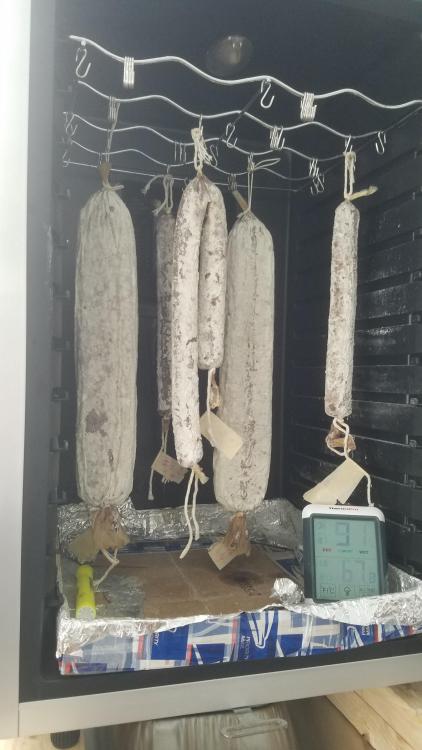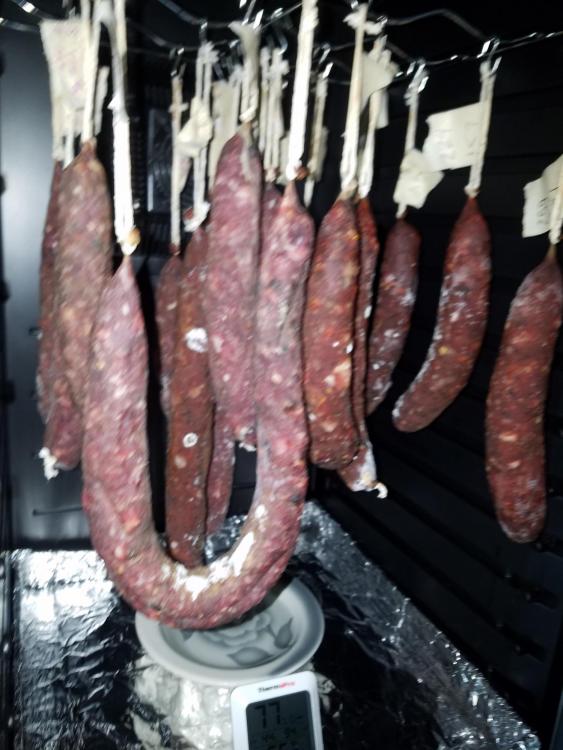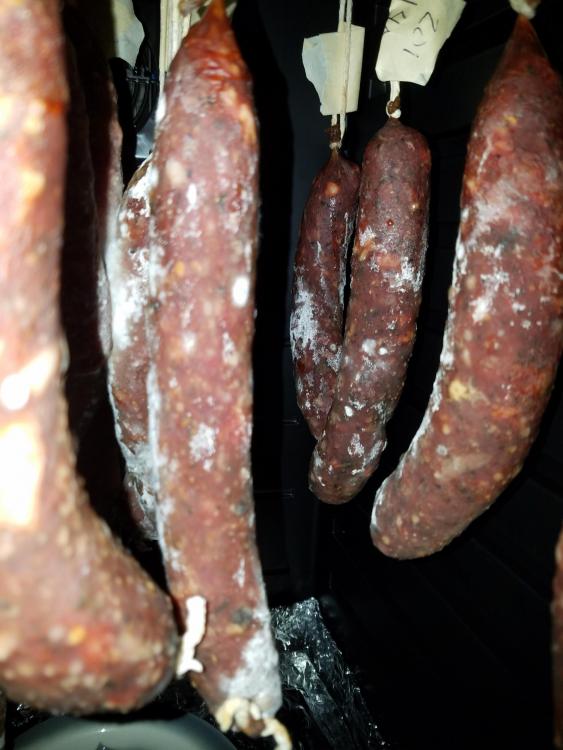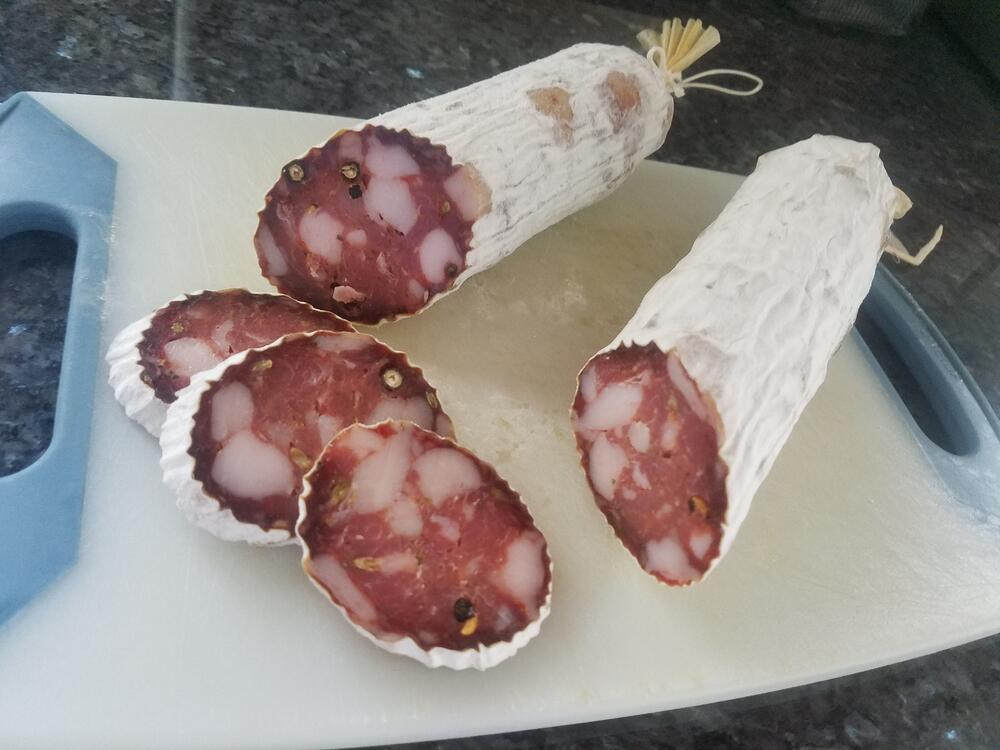
Joe Wood
participating member-
Posts
49 -
Joined
-
Last visited
Content Type
Profiles
Forums
Store
Help Articles
Everything posted by Joe Wood
-
I've been making dry cured sopressata {I never get the spelling right} for over one year now and I've learned a few things... If anyone is interested in saving $$$ let me know... 1. It can be VERY expensive if we don't watch what we pay for supplies like STARTER CULTURE @ $28.00 FOR 28 GRAMS... Protective white mold called PENICILLIUM NALGIOVENSE also at around $28.00 for less than an ounce... Casings can cost over $2.00 EACH. 2. If you watch the sales in your local supermarket you can get the meat very reasonably {as in CHEAP !} Some supermarkets will even grind the meat for you free which is a big step saver.
-
My friend chickened out on the quinoa... So I have no information... As for me, however, the big "Q" is in my rear view mirror... I've made several batches of soprassata {never get the spelling right} using yogurt for a starter... I have no science about portions though... For a five lb. batch of meat I use about half of a 4 oz. cup... It's worked out perfectly every time... After filling the casings I put them in the oven WITH OVEN LIGHT ON as a heat source... The oven light gets the temp. to about 90 degrees F. After 48 hrs. I move them to the wine cooler at 60 degrees F. Another tip I use to save $$$ : Save the peeled collagen casings from cured salamis... Freeze them in zippy bags. When you make the next batch rub one of the old casings with the white powder on the new batch and watch that good ole penicillium nalgovence {sp} start to grow again ... You'll never have to buy it again !
-
No on the quinoa... A friend is doing that one and we'll get his esults when he's done...
-
Well I have to admit the blue cheese-orange zest recipe was a disappointment for me... While the salami came out nicely aged and tasty there was no flavor of the blue cheese at all . It seemed to have disappeared into the meat... The orange zest {I used the zest of an entire orange peel }.was slightly detectable but not worth doing again... Just had to try it though...
-
Well I have to admit the blue cheese-orange zest recipe was a disappointment for me... While the salami came out nicely aged and tasty there was no flavor of the blue cheese at all . It seemed to have disappeared into the meat... The orange zest {I used the zest of an entire orange peel }.was slightly detectable but not worth doing again... Just had to try it though...
-
I won't do this one again...
-
Well I have to admit the blue cheese-orange zest recipe was a disappointment for me... While the salami came out nicely aged and tasty there was no flavor of the blue cheese at all . It seemed to have disappeared into the meat... The orange zest {I used the zest of an entire orange peel }.was slightly detectable but not worth doing again... Just had to try it though...
-
I've been away for quite a while. The fermenting w/ yogurt trick came from somewhere in Greece... I've used it in my last two batches of Soprasatta with great success... I will pass on what I learned BEFORE trying it... 1. Use plain regular {not non-fat} yogurt 2. Make sure the carton reads "CONTAINS LIVE CULTURES" 3. Use 4 oz. of yogurt by volume to5 lb. of meat... I plan to do this from now on... I cannot detect any difference in the end result... flavor and texture are the same as using a starter culture...
-
Thanks for your interest in this venture... I'll be sure to keep posting... Sorry... I forgot to mention using the pink salt in the recipe... I DID USE IT... 5 grams... I also added liquid 8oz. of red wine, 13 grams of table sugar... The purpose of the blue cheese and orange zest was simply to try a different recipe... I read it on another site and the gentleman said it was fantastic... We'll see how this turns out... As for the brand of blue I just bought a small container marked "BLUE CHEESE CRUMBLES
-
I just copied someone else's recipe containing the cheese... the function of the cheese is to add to the flavors of the finished product... the author said it was delicious I cannot comment on that because mine is still aging... I would also imagine that the blue cheese should have some live cultures possibly adding to the fermentation (?)... the orange peel zest is also there for flavors...
-
I should have mentioned it before... I did use the pink salt ... I also added red wine {8 liquid oz.} and 13 grams of sugar... The blue cheese crumbles can be found in any food store {at least here in the USA}
-
No I did not... Actually I just bought 80/20 ground beef from restaurant depot and used 5 lbs. of that because the fat content was correct at 20%... I'm just delighted about the fermentation using live yogurt though... The recipe I used is different too... 5 lbs. 80/20 ground beef 3.heads finely chopped fresh garlic the zest of one whole orange chopped finely 3 % kosher salt by weight {3% of 5 lbs.} * 12 oz. of blue cheese pieces FROZEN before adding to the meat and other ingredients *I was afraid the blue cheese would mush when added to the meat... It did not... Frozen is the way to go... CRUMBLED FIRST... Then frozen... **I also am able to transfer the mold600 from batch to batch quite easily... Paying about $29.00 for one ounce makes me conservative & creative... If anyone's interested just ask me...
-
I am pleased to report to the community that I did in fact make a batch of hard salami using only a few ounces of plain yogurt to ferment the meat... The fermentation worked beautifully... I'm told the finished product will be indistinguishable from batches using commercial starters... I've been in touch with folks from many parts of the globe Europe, Australia, India, Africa and all say they use yogurt as a starter... Just be sure to get yugurt which reads: "CONTAINS ACTIVE CULTURES"...
-
many thanks to you AAQuesada... You are the only person who has responded to the YOGURT query I posted... I'm absolutely a "newbee" in making hard salami... I've made about 5 batches and learned something from every batch... I have not, however, checked the PH in any of them... This may be a big mistake but I've had no failures yet {fingers crossed}... I follow very strict sanitation rules & procedures... I use the pink salt and Bactoferm T-SPX ... Your words "active cultures" is very helpful... I would not have thought of it... joe Wood
-
I will do a 5lb. batch... I as well have nothing against pork fat... I just recently heard about the quinoa... just trying to learn all I can about making hard salami... Would you have an idea what the replacement measurements would be? Would it be equal weight? Or perhaps something else?... I ccannot find the answer on line... While I have your attention may I ask if you've heard of using plain YOGURT to ferment the meat? Again how much yogurt to a 5 lb. batch?
-
I'm in Naples FL for the winter and cannot readily find fatback or hog fat for making dry cured salami... 20% is what I use in my batches or 5lb., 10lb., and 15lb... A good friend who's also into charcuterie told me of people using QUINOA as part or all of the fatback... Here is just one article of several articles on it... My question is does anyone have any experience doing this? Thanks in advance Different approaches have been previously studied in order to reduce the fat content of dry-cured sausages. Among them, the use of polysaccharides, such as fiber, gums, or starch, have been proposed for fat replacing. Although scarcely studied, it is likely that starchy grains and vegetables might also be used as potential fat replacers in those sausages. Quinoa is a starchy seed with high nutritive value, which contains substances of technological interest in dry-cured manufacturing. The aim of this study was to assess the effect of replacing fat by quinoa on the quality characteristics of a small diameter dry-cured sausage. Three types of sausages were prepared: a control (C; no fat replacement; 30% of pork back-fat), a quinoa half-fat (50% of fat replacement; 15% of pork back-fat), and a quinoa low-fat (LF; 85% of fat replacement; 4.5% of pork back-fat) sausage. Sausages were analyzed for proximate and microbial composition, volatile compounds, and instrumental texture and color. Descriptive and hedonic sensory analyses were also performed. Fat reduction resulted in higher aw , protein content, hardness, chewiness and redness values and spice-derived volatile levels, and in lower cohesiveness values (P < 0.05). Furthermore, the descriptive sensory analysis showed a higher pungent flavor and lower juiciness in LF sausages than in C sausages (P < 0.05). In spite of those differences, fat reduction did not result in a decreased overall acceptance of the sausages by consumers. images/icons/svgicons/researchgate-logo-white.svg
-
Has any of our members fermented salami or sopprasata using yogurt to ferment the meat or other live cultures successfully? I was reading on a foreign blog site about it...
-
Hello to all hard salami buffs... I've been reading several recipes for hard aged salami containing POWDERED MILK... One such recipe calls for ONE FULL CUP OF POWDERED MILK to every five lbs. of meat... I read it was used as a BINDER {?} Can anyone who does this or is familiar with it explain what it does ? How it effects the final product?
-
Has anyone experienced a batch of hard salami "slowing down" the curing process? By this I mean it's almost three weeks in , covered completely with nice white penicillium nalgiovense, but not getting any drier... Temp and humidity are within normal range... Any thoughts?
-
Hello, I cannot comment on either book however I just finished reading about ALL BEEF HARD SALAMI... The basic recipe was the same as one using some {or all} pork... This recipe did not allow the use of any but artificial casings made from BEEF collagen... The lean to fat was the same at 80/20... Thinking of trying it myself... Joe Wood
-
Being new at this I want to be sure vacuum sealing will preserve the salami... Everything I read talks about preserving hard salami by wrapping it in butcher's paper or similar... Thank you for responding to my inquiry...Joe
-
Does anyone have any experience with vacuum sealing hard salami?... if so any advice or tips you may have would be appreciated... I did my latest batch of hard salami in non-edible collagen casings... I vacuum sealed them with the casings left on... I have seen hard salami vacuum sealed without casings as well... Joe Wood
-
Well this topic is ten yrs. old. But I have to agree with CureCraftKing... I pretty much do the same thing ... No ph testing but being careful tp follow rules about sanitation...
-
Where I live pork loin is often on sale for $2.00 or even less... Has anyone an opinion about using just pork loin for the meat along with the 20% pork fat? ? I've read that any meat can be used to make the cured salami... I'd like to hear from anyone before I try it...
-
Below is a picture of my second batch of hard salami... This is the batch where I hand diced the 20% fat to achieve more definition... Not my idea... I saw it on line but kinda like it...






